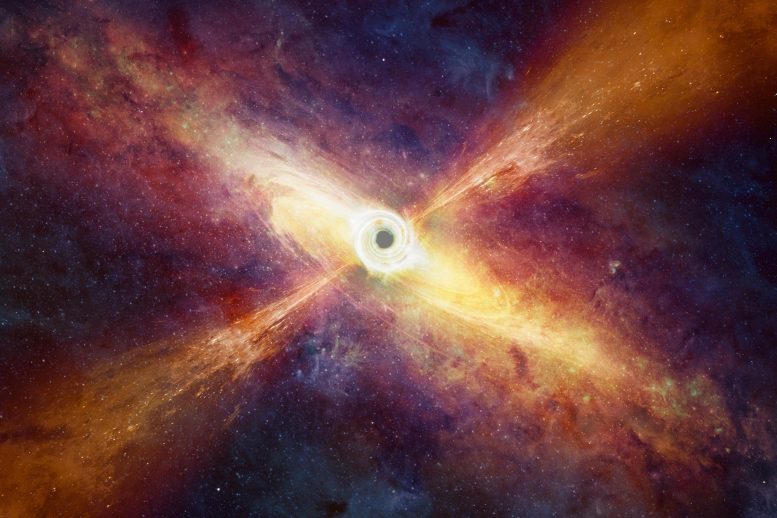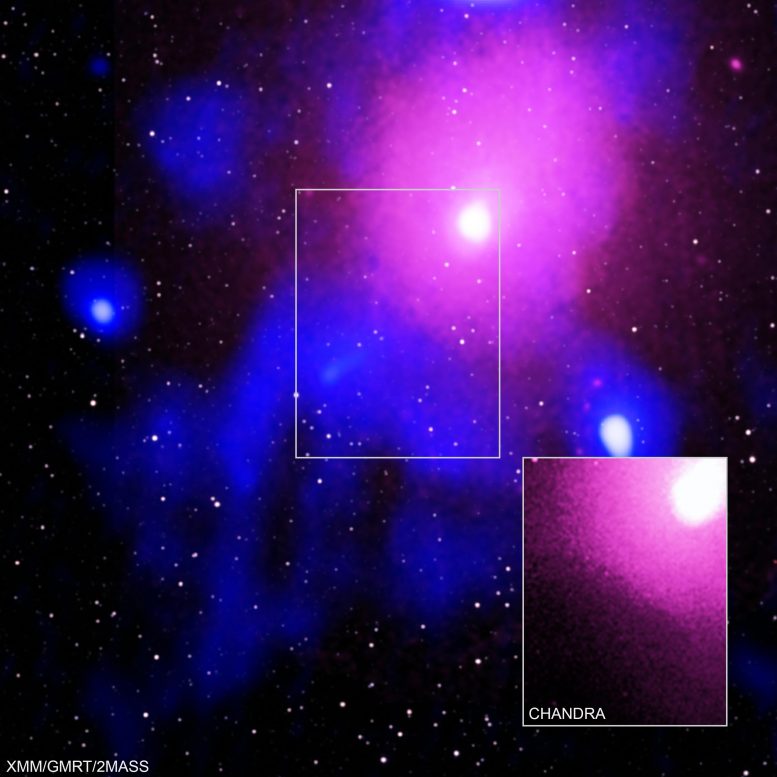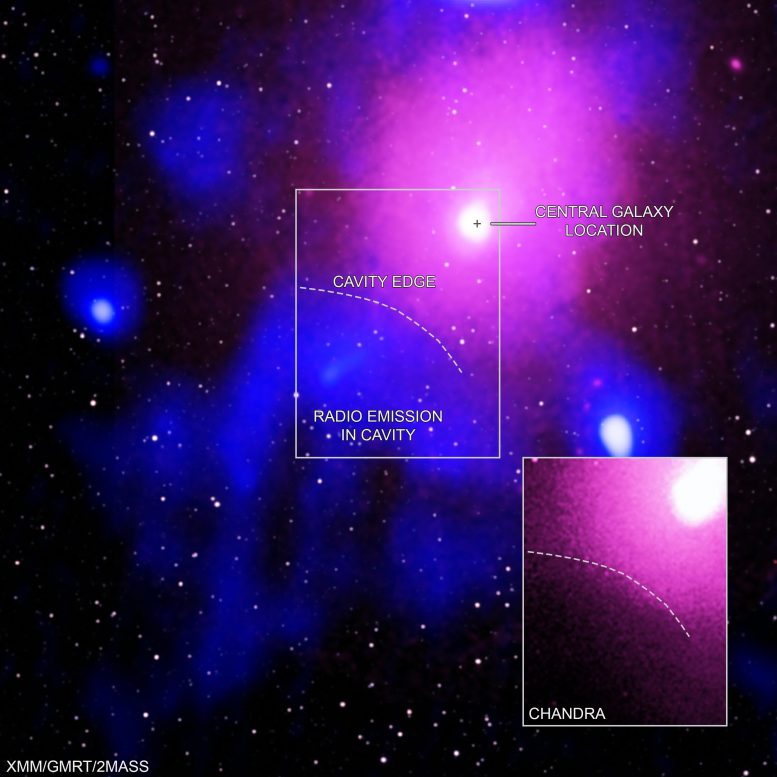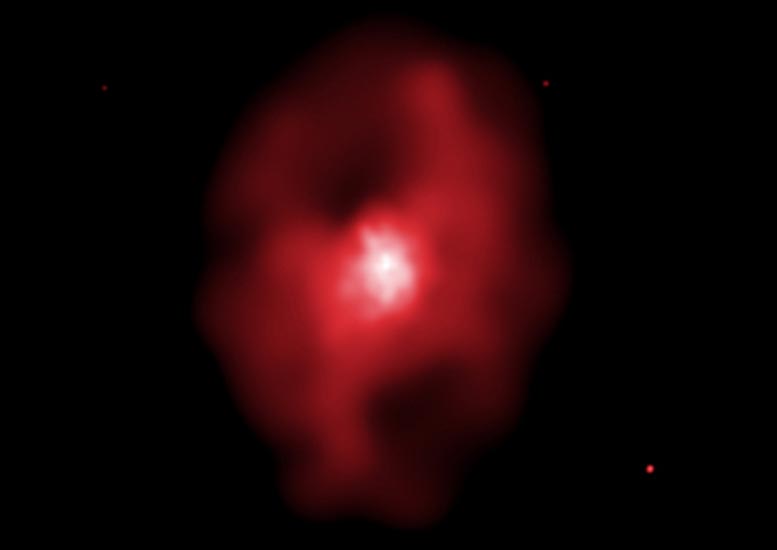
Astronomers using ESA’s XMM-Newton and NASA’s Chandra X-ray space observatories, along with radio telescopes on ground, have spotted the aftermath of the most powerful explosion ever seen in the Universe.
The huge outburst occurred in the Ophiuchus galaxy cluster, a large cosmic conglomerate with thousands of galaxies, hot gas and dark matter held together by gravity, lying some 390 million light years away. In particular, the eruption is linked to powerful jets released by the supermassive black hole that sits at the core of the cluster’s central galaxy and actively feeds on the surrounding gas, occasionally blasting off large amounts of matter and energy.

This extremely powerful eruption occurred in the Ophiuchus galaxy cluster, which is located about 390 million light-years from Earth. Galaxy clusters are the largest structures in the Universe held together by gravity, containing thousands of individual galaxies, dark matter, and hot gas. Credit: X-ray: NASA/CXC/Naval Research Lab/Giacintucci, S.; XMM:ESA/XMM; Radio: NCRA/TIFR/GMRTN; Infrared: 2MASS/UMass/IPAC-Caltech/NASA/NSF
In this image, the diffuse hot gas pervading the cluster is revealed through X-ray observations from XMM-Newton (shown in pink), radio data from the Giant Metrewave Radio Telescope (shown in blue), and infrared data from the 2MASS survey (shown in white). The inset in the lower right shows a zoomed-in X-ray view based on Chandra data (also shown in pink), while bright dots sprinkled across the image reflect the distribution of foreground stars and galaxies.
The X-ray emission reveals the edge of a large cavity, carved in the hot gas by the black hole jets. The cavity is filled with radio emission from electrons accelerated to almost the speed of light – likely a result of the black hole’s feeding activity – providing evidence that an eruption of unprecedented size took place there.

This extremely powerful eruption occurred in the Ophiuchus galaxy cluster, which is located about 390 million light-years from Earth. Galaxy clusters are the largest structures in the Universe held together by gravity, containing thousands of individual galaxies, dark matter, and hot gas. Credit: X-ray: NASA/CXC/Naval Research Lab/Giacintucci, S.; XMM:ESA/XMM; Radio: NCRA/TIFR/GMRTN; Infrared: 2MASS/UMass/IPAC-Caltech/NASA/NSF
In 2016, a team of astronomers had found first hints of the giant explosion in the Chandra data, reporting the discovery of an unusual curved edge in the X-ray image of the Ophiuchus galaxy cluster. They considered whether this edge might point to a cavity in the hot gas linked to the black hole jets, but discarded the possibility at the time.
In a more recent study, published in February 2020, Simona Giacintucci of the Naval Research Laboratory in Washington, DC (US) and collaborators detected the curved edge also in XMM-Newton data, confirming the earlier Chandra observation. In this study, the scientists combined the X-ray data with radio wave observations of the Ophiuchus cluster from the Murchison Widefield Array (MWA) in Australia and the Giant Metrewave Radio Telescope (GMRT) in India, revealing that the curved edge delimits a region filled with radio-emitting gas and is indeed part of the wall of a cavity in the hot gas.

MS 0735+74 was the previous record-holder for the most powerful eruption discovered in the universe. This Chandra image shows two vast cavities — each 600,000 light years in diameter — in the hot, X-ray emitting gas that pervades the galaxy cluster MS 0735.6+7421 (MS 0735 for short). Although the cavities contain very little hot gas, they are filled with a two-sided, elongated, magnetized bubble of extremely high-energy electrons that emit radio waves. Credit: NASA/CXC/Ohio U./B.McNamara
The black hole eruption that created the cavity released an amount of energy about five times greater than that involved in the most powerful event of this type known to date, observed in the galaxy cluster MS0735.6+7421.
Read Record-Breaking, Gargantuan Black Hole Eruption and Biggest Explosion in the History of the Universe Detected by Astronomers for more on this discovery.
References:
“Discovery of a Giant Radio Fossil in the Ophiuchus Galaxy Cluster” by S. Giacintucci, M. Markevitch, M. Johnston-Hollitt, D. R. Wik, Q. H. S. Wang and T. E. Clarke, 27 February 2020, The Astrophysical Journal.
DOI: 10.3847/1538-4357/ab6a9d
arXiv: 2002.01291
“Deep Chandra study of the truncated cool core of the Ophiuchus cluster” by N. Werner, I. Zhuravleva, R. E. A. Canning, S. W. Allen; A. L. King; J. S. Sanders, A. Simionescu, G. B.Taylor, R. G. Morris and A. C. Fabian, 16 May 2016, Monthly Notices of the Royal Astronomical Society.
DOI: 10.1093/mnras/stw1171








 User Center
User Center My Training Class
My Training Class Feedback
Feedback












Comments
Something to say?
Login or Sign up for free